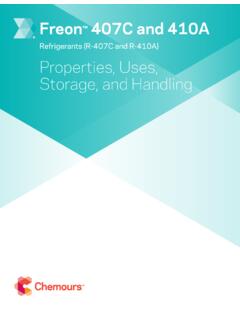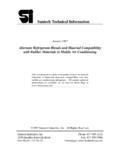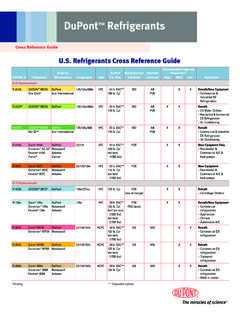Transcription of Refrigerant (R-134a) Properties, Uses, Storage, and Handling
1 Freon 134aRefrigerant (R- 134a )Properties, Uses, Storage, and HandlingFreon 134aRefrigerant3 Table of ContentsIntroduction ..4 Background ..4 Freon 134a An Environmentally Acceptable Alternative ..4 Uses ..4 Physical Properties ..5 Chemical/Thermal Stability ..5 Thermal with Metals and Refrigeration Lubricants ..5 Stability with Foam Chemicals ..8 compatibility Concerns If Freon 134a and CFC-12 Are Mixed ..8 Materials compatibility ..8 Plastics ..9 Elastomers ..9 Hose Permeation ..12 Desiccants ..12 Refrigeration Lubricants ..12 Safety ..19 Inhalation Toxicity ..19 Cardiac Sensitization ..19 Skin and Eye Contact ..20 Spills or Leaks ..20 Combustibility of Freon 134a ..20 Combustibility within Chlorine ..21 Monitors and Leak Detection ..21 Types of Detectors ..21 Nonselective Detectors ..21 Halogen-Selective Detectors ..22 Compound-Specific Detectors ..22 Fluorescent Dyes.
2 22 Shipping, Storage, and Handling ..22 Shipping Containers in the United States ..22 Bulk Storage Systems ..23 Converting Bulk Storage Tanks from CFC-12 to Freon 134a ..23 Material compatibility Concerns ..24 Handling Precautions for Freon 134a Shipping Containers ..25 Recovery, Reclamation, Recycle, and Disposal ..25 Recovery ..25 Reclamation ..25 Recycle ..26 Disposal ..26 Freon (%)100806040200 TRANSMITTANCE (%)4,0003,0002,5002,0001,8001,6001,4001, 2001,0008006004002003,500 MICRONS WAVENUMBER (CM-1) MICRONS4 IntroductionBackgroundFreon 134a was introduced by Chemours as a replacement for chlorofluorocarbons (CFCs) in many applications. CFCs, which were developed over 60 years ago, have many unique properties. They are low in toxicity, nonflammable, noncorrosive and compatible with other materials. In addition, they offer the thermodynamic and physical properties that make them ideal for a variety of uses.
3 CFCs are used as refrigerants; as blowing agents in the manufacture of insulation, packaging and cushioning foams; as cleaning agents for metal and electronic components; and in many other , the stability of these compounds, coupled with their chlorine content, has linked them to depletion of the earth s protective ozone layer. As a result, Chemours has phased out production of CFCs and introduced environmentally acceptable alternatives, such as hydrofluorocarbon (HFC) 134a An Environmentally Acceptable AlternativeFreon 134a does not contain chlorine; therefore, it has an ozone depletion potential (ODP) of zero. Listed below are all generic and Chemours trade names: Hydrofluorocarbon- 134a Freon 134a HFA- 134a Freon 134a Freon 134a (Auto) Formacel Z-4 (foam blowing agent market) HFC- 134a (aerosol market)The chemical properties of Freon 134a are listed 134a Chemical InformationChemical Name 1,1,1,2-tetrafluoroethaneMolecular Formula CH2 FCF3 CAS Registry Number 811-97-2 Molecular Weight StructureFFFCCHFHUsesFreon 134a can be used in many applications that currently use dichlorodifluoromethane (CFC-12).
4 These include refrigeration, polymer foam blowing, and aerosol products. However, equipment design changes are sometimes required to optimize the performance of Freon 134a in these thermodynamic and physical properties of Freon 134a , coupled with its low toxicity, make it a very efficient and safe replacement Refrigerant for CFC-12 in many segments of the refrigeration industry, most notably in automotive air conditioning, appliances, small stationary equipment, medium-temperature supermarket cases, and industrial and commercial chillers. Table 1 provides a comparison of the theoretical performance of CFC-12 and Freon 134a at medium-temperature 1. Infrared Spectrum of Freon 134a Vapor at 400 mmHg Pressure ( kPa) in a 10-cm CellFreon 134aRefrigerant5 Table 1. Theoretical Cycle Comparison of CFC-12 and Freon 134a *CFC-12 Freon 134aCapacity (as % CFC-12) of Performance (COP) Temperature, C ( F)Exit Pressure, kPa (psia) ( )1349 ( ) ( )1473 ( )Compression *Temperatures were as follows: Condenser, C ( F); Evaporator, C ( F); Compressor Suction, C ( F); Expansion Device, C ( F).
5 Freon 134a can be used to replace CFC-11, CFC-12, and HCFC-142b in many thermoplastic foam applications. Freon 134a can be used as a replacement for CFC-12 and HCFC-141b in thermoset foams. HFC- 134a features properties that are advantageous for high value-in-use products and meets the requirements of safety/environmental issues. Freon 134a is nonflammable, has negligible photochemical reactivity, and low vapor thermal conductivity. Freon 134a is also being developed for use in pharmaceutical inhalers because of its low toxicity and nonflammability. Other aerosol applications may use Freon 134a where these properties are critical. See Chemours technical bulletin for additional information on aerosol applications of Properties Physical properties of Freon 134a are given in Table 2 and Figures 2 through 8. Additional physical property data may be found in other Chemours publications.
6 Technical bulletin "Transport Properties of Freon Refrigerants" contains viscosity, thermal conductivity, and heat capacity data for saturated liquid and vapor, in addition to heat capacity data and heat capacity ratios for both saturated and super-heated vapors. Thermodynamic tables in English and SI units are available in technical bulletins, "Thermodynamic Properties of HFC- 134a ". Liquid and vapor densities are included in the thermodynamic StabilityThermal DecompositionFreon 134a vapors will decompose when exposed to high temperatures from flames or electric resistance heaters. Decomposition may produce toxic and irritating compounds, such as hydrogen fluoride. The pungent odors released will irritate the nose and throat and generally force people to evacuate the area. Therefore, it is important to prevent decomposition by avoiding exposure to high with Metals and Refrigeration LubricantsStability tests for refrigerants with metals are typically performed in the presence of refrigeration oils.
7 The results of sealed tube stability tests are available for CFC-12/mineral oil combinations, which have shown long-term stability in contact with copper, steel, and aluminum in actual refrigeration systems. Polyalkylene glycol (PAG) and polyol ester (POE) lubricants are used with Freon 134a . Sealed tube tests were run to determine the relative long-term stability of Freon 134a /metals in the presence of these method followed was generally the same as ASHRAE 97 with several minor modifications. A 3-mL volume of Refrigerant /lubricant solution was heated in the presence of copper, steel, and aluminum strips in an oven for 14 days at 175 C (347 F). Both the neat lubricant and a mixture of lubricant and Refrigerant (50/50 volume ratio) were tested. Visual ratings were obtained on both the liquid solutions and the metal coupons after the designated exposure time. The visual ratings ranged from 0 to 5, with 0 being the the visual ratings were obtained, sample tubes were opened and the lubricant and Refrigerant (if present) were analyzed.
8 The lubricant was typically checked for halide content and viscosity, while the Refrigerant was examined for the presence of decomposition products. Table 3 summarizes typical data for both Freon 134a and CFC-12. Visual ratings are listed for the neat lubricant, the lubricant/ Refrigerant solution, and the three metals that were present in the lubricant/ Refrigerant solutions. Viscosity was determined on the unused lubricant, the tested neat lubricant, and the lubricant tested in the presence of Refrigerant . A percent change was calculated for the two tested lubricants. The decomposition products listed are HFC-143a (the predominant decomposition product for Freon 134a ) and fluoride ion. Both species are typically measured in the low parts per million (ppm) the CFC-12/mineral oil combinations have been proven in actual service, these tests indicate that Freon 134a /PAG and Freon 134a /POE solutions have acceptable chemical stability.
9 In several other tests, results have confirmed that the Freon 134a molecule is as chemically stable as 134aRefrigerant6 Table 2. Physical Properties of Freon 134aPhysical PropertyUnitFreon 134aChemical Name Ethane, 1,1,1,2-TetrafluoroChemical Formula CH2 FCF3 Molecular Point at 1 atm ( kPa or bar) C F Point C F Temperature C Volumem3/kgft3 x 10 Densitykg/m3 (Liquid) at 25 C (77 F)kg/m3lb/ft31, (Saturated Vapor) at Boiling Pointkg/m3 Capacity (Liquid) at 25 C (77 F)kJ/kg KBtu/lb ( F) Capacity (Vapor at Constant Pressure) at 25 C (77 F) (1 atm) ( kPa or bar)kJ/kg KBtu/lb ( F) Pressure at 25 C (77 F) of Vaporization at Normal Boiling PointkJ/ Conductivity at 25 C (77 F)LiquidVapor at 1 atm ( kPa or bar)W/m KBtu/hr ft ( F)W/m KBtu/hr ft ( F) at 25 C (77 F)LiquidVapor at 1 atm ( kPa or bar)MPa S (cP)MPa S (cP) of Freon 134a in Water at 25 C (77 F) and 1 atm ( kPa or bar)wt% of Water in Freon 134a at 25 C (77 F)
10 Wt% Limits in Air at 1 atm ( kPa or bar)vol %NoneAuto-Ignition Temperature C F7701,418 Ozone Depletion Potential (ODP) 0 Halocarbon Global Warming Potential (HGWP) (For CFC-11, HGWP = 1) Warming Potential (GWP) (100 yr ITH) (GWP For CO2, GWP = 1) 1,200 TSCA Inventory Status Reported/IncludedToxicity AEL* (8- and 12-hr TWA) ppm (v/v)1,000*Acceptable exposure limit (AEL) is an airborne inhalation exposure limit established by Chemours that specifies time-weighted average (TWA) concentrations to which nearly all workers may be repeatedly exposed without adverse : kPa is absolute 134aRefrigerantTemperature, C0 40 20020406080100200150100500 5005001,0001,5002,0002,5003,0003,500 Temperature, FWeight ppm Water in Freon 134a100101,00010,0001 Temperature, CPressure, kPa 100 500501001501, , FPressure, psia250200150100500 50 100 1507 Table 3. Stability of Freon 134a with Metals and Lubricating OilsOilMineral OilMineral OilUCON RO-W-6602*Mobil EAL Arctic 32**Castrol Icematic SW 100**Oil Viscosity, cSt at 40 C (104 F) 134aFreon 134aFreon 134aRatingsNeat Oil 000 Oil/Refrigerant44000 Copper22000 Iron33000 Aluminum22000 Viscosity Change% Change NeatNDND<1 Change with RefrigerantNDND AnalysisHFC-143a, ppmNDND<7<3< , ppmND420< <7*Polyalkylene glycol lubricant.







